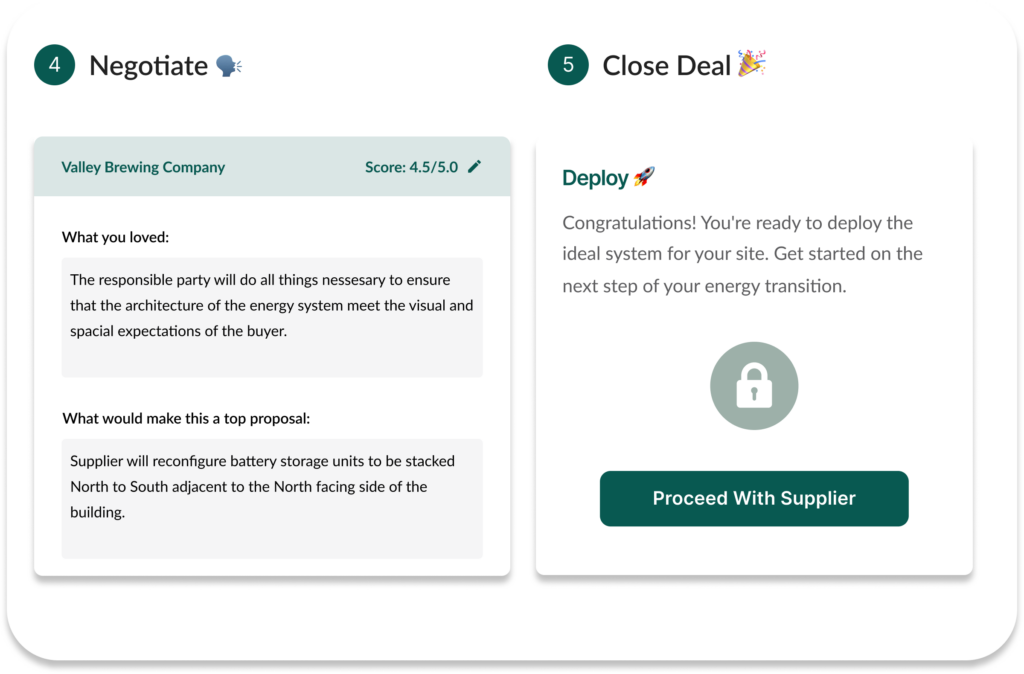In the ever-evolving landscape of commercial solar, running an effective Request for Proposal (RFP) process can feel like navigating a labyrinth. But fear not, this guide will illuminate the path to securing the right solar installer for your project, avoiding common pitfalls, and maximizing your return on investment.
The RFP: Your Solar Project’s North Star
Let’s face it: the solar industry is as fragmented as a broken mirror. With a dizzying array of installers, developers, and equipment suppliers, how do you ensure you’re getting the best deal without compromising on quality? The answer lies in crafting a robust solar RFP process.
Step 1: Define Your Solar Ambitions
Before you even think about reaching out to installers, take a step back and ask yourself:
- What are your energy needs, both current and future?
- What are your financial targets? (Think payback periods and IRR)
- What are your sustainability goals?
These aren’t just rhetorical questions. Your answers will form the backbone of your RFP, guiding installers to provide solutions tailored to your needs.
Step 2: Speak the Solar Language
Your RFP should be a beacon of clarity in the often murky waters of solar proposals. Here’s what to include:
- Technical Specs: Be as specific as you can about system type, location, and key components. If possible, outline:
- The type of system (rooftop, ground-mounted, carport, etc.)
- Preferred or required equipment brands
- Any site-specific constraints or requirements
- Financial Assumptions: Lay out your utility tariffs, expected rate escalations, and corporate discount rates. Don’t make installers guess. Be sure to include:
- Current utility tariff structures and rates
- Expected utility rate escalation (typically 3-5% annually)
- Your company’s discount rate or hurdle rate for investments
- Any internal cost of carbon, if applicable
- Desired payback period or internal rate of return (IRR)
- Operational Requirements: Are you expecting growth? Do you have critical loads that need uninterrupted power? Spell it out. Consider including:
- Current energy consumption patterns
- Projected changes in energy demand over the next 5-10 years
- Any critical operations requiring uninterrupted power supply
- Desired sustainability metrics or carbon reduction goals
Pro tip: If you’re unsure about the technical specs, consider using a platform like VECKTA that offers automated system configurations. It’s a cost-effective middle ground between DIY and hiring expensive consultants.
Step 3: Define the Rules of Engagement
Clear roles and responsibilities are the bedrock of a successful solar project. Your RFP should answer:
- Who’s handling structural assessments and permits?
- What performance guarantees are you expecting?
- Who’s responsible for ongoing operations and maintenance?
- Who will manage interconnection agreements with the utility?
- What are the expectations for system monitoring and reporting?
Remember, ambiguity at this stage can lead to disputes and cost overruns down the line. The more specific you can be, the better equipped solar installers will be to provide accurate and tailored proposals.
The Players: EPCs, Developers, and Suppliers
Understanding the roles of different players in the solar ecosystem can help you make a more informed choice:
- EPCs (Engineering, Procurement, and Construction): These are your one-stop shops, handling everything from design to construction.
- Developers: Think of them as the project managers, coordinating financing, site selection, and overall development.
- Equipment Suppliers: The folks who make and distribute the nuts and bolts (or rather, panels and inverters) of your system.
Each brings different strengths to the table. Your job is to find the right mix for your project.

The Financing Decision: Self-Fund or Third-Party?
Here’s where things get interesting. Your choice of financing model can dramatically affect not just your costs, but also your relationship with your solar installer.
Self-Financing: The DIY Approach
If you’ve got the capital, self-financing puts you in the driver’s seat. You own the system outright, reap all the benefits (including those juicy tax incentives), and have full control. But remember, with great power comes great responsibility – and risk.
Third-Party Financing: The Hands-Off Approach
Don’t want to tie up your capital? Third-party financing options like Power Purchase Agreements (PPAs) or Energy-as-a-Service (EaaS) models might be your ticket. But read the fine print. These contracts can span 10-25 years. Make sure you understand your buyout options and what happens when the contract ends.
The Evaluation Gauntlet: Beyond the Bottom Line
You’ve sent out your RFP, and the bids are rolling in. Now what? Resist the urge to simply go with the lowest bidder. Instead, create a balanced scorecard that considers:
- Pricing and implementation timelines
- Supplier experience with similar projects
- Team credentials
- Proposal completeness and compliance
- Project approach and innovation
Pro tip: Assign weights to these criteria based on your priorities. It’ll make your final decision more objective and defensible.
Leverage the Power of a Marketplace
In an industry as fragmented as solar, marketplace platforms like VECKTA can be your secret weapon. They offer a range of benefits that can streamline your RFP process and help you make more informed decisions.
Key Benefits of Using a Marketplace
- Transparency: Standardized evaluation criteria make “apples-to-apples” comparisons a breeze.
- Centralization: All your supplier info, contracts, and Q&As in one place.
- Efficiency: Streamlined collaboration across all stakeholders.
- Risk Management: Insights into supplier reliability and performance benchmarks.
Best Practices for Marketplace RFPs
- Be Specific, But Flexible: While it’s important to clearly state your requirements, leave some room for suppliers to propose innovative solutions you might not have considered.
- Set Realistic Timelines: Give suppliers enough time to prepare thorough, competitive bids. Rush jobs rarely yield the best results.
- Engage Stakeholders Early: Use the marketplace’s collaboration tools to involve all relevant stakeholders from the beginning. This can prevent delays and conflicts later in the process.
- Keep an Open Mind: You might receive proposals from suppliers you’re not familiar with. Judge each bid on its merits rather than solely on brand recognition.
- Use Data-Driven Decision Making: Leverage the data and analytics provided by the marketplace to make objective, fact-based decisions.
Case Study: Marketplace Success
Company B used a solar marketplace platform to run their RFP for a 2MW solar installation across multiple sites. They uploaded their energy consumption data, site details, and project requirements to the platform. The marketplace’s algorithms matched them with seven pre-qualified suppliers, each with experience in similar multi-site projects. Company B used the platform’s standardized forms to easily compare technical specifications, pricing structures, and proposed timelines.
When questions arose, the platform’s messaging system allowed for quick clarifications, visible to all bidders to ensure fairness. The marketplace’s analytics tools helped Company B weigh factors like price, experience, and proposed system performance.
In the end, Company B received five highly competitive bids, all meeting their core requirements. The standardized format made comparison straightforward, and the platform’s reporting tools helped them easily share insights with stakeholders.
The entire process, from RFP creation to bid selection, took just six weeks – half the time they had budgeted. Plus, the winning bid came in 15% under their initial budget projections, thanks to the highly competitive nature of the process.
By leveraging a marketplace platform, Company B not only saved time and secured a great deal, but they also gained valuable market insights that will inform their energy strategies for years to come.

The Bottom Line: Your Solar Success Playbook
Running an effective solar RFP process isn’t rocket science, but it does require careful planning and execution. Here’s your playbook for success:
- Know Thyself: Clearly define your energy needs, financial targets, and sustainability goals.
- Speak Clearly: Craft an RFP that leaves no room for ambiguity.
- Set the Rules: Clearly define roles and responsibilities.
- Choose Your Financing Wisely: Understand the implications of self-financing vs. third-party options.
- Look Beyond Price: Evaluate bids holistically, not just on cost.
- Know the Players: Understand the roles of EPCs, developers, and suppliers.
- Leverage Technology: Consider using marketplace platforms to streamline the process.
Remember, the goal isn’t just to get solar panels on your roof. It’s to secure a long-term energy solution that drives both economic and environmental value for your organization. With this guide in hand, you’re well-equipped to navigate the solar RFP maze and emerge victorious on the other side.
Now go forth and harness the power of the sun. Your bottom line (and the planet) will thank you.


